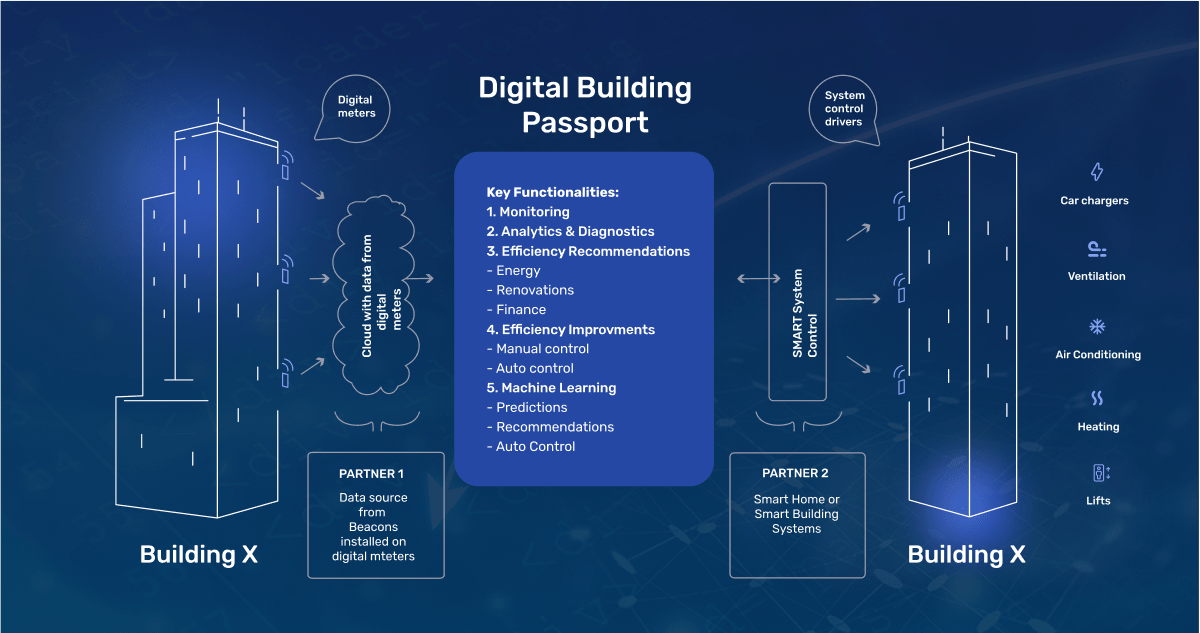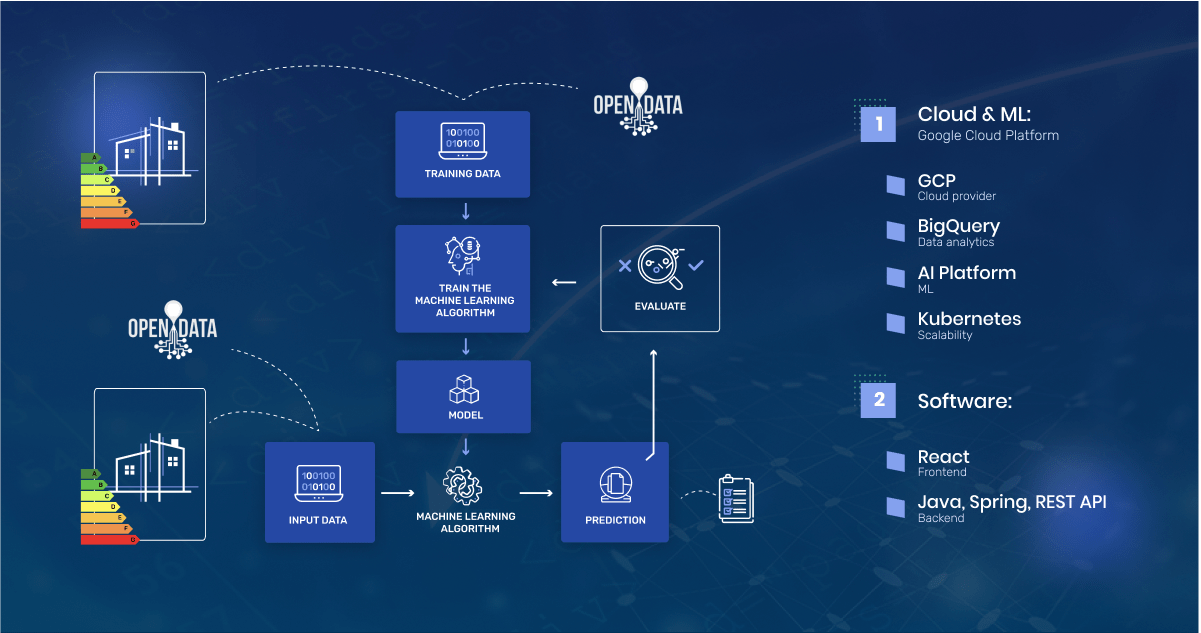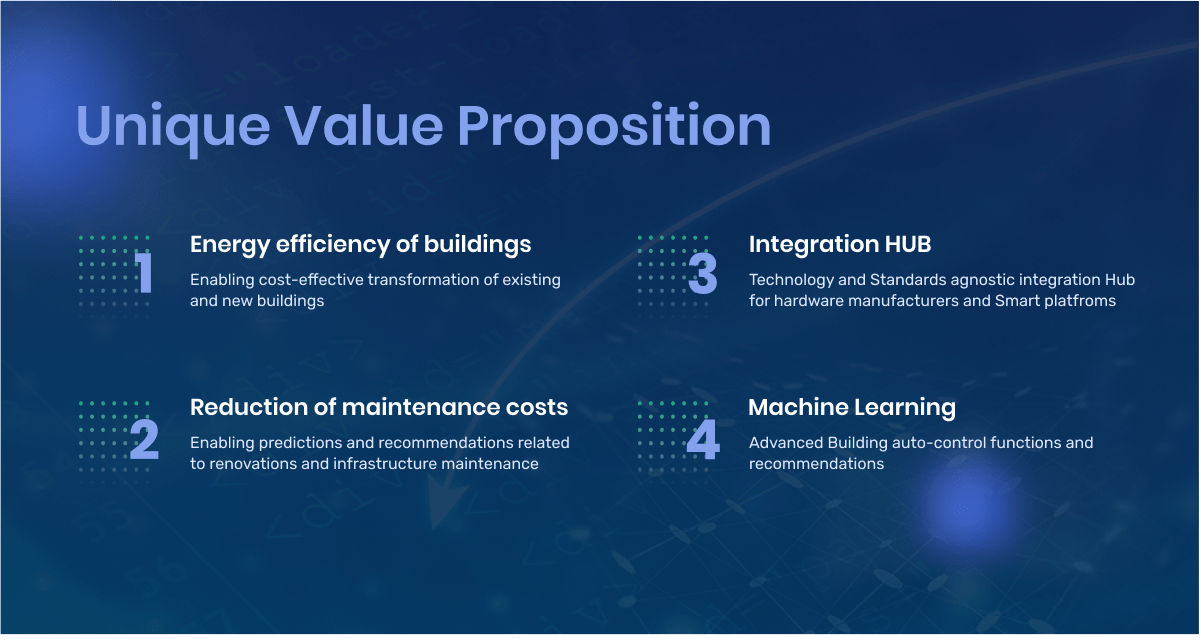Buildings are responsible for around 40% of energy consumption in the European Union and 36% of greenhouse gas emissions. For this reason, a specific directive has been issued to reduce energy consumption and decarbonize the building stock in the EU. Property owners and managers must take into account additional obligations. You have relatively little time to make the necessary renovations, so find out how to meet the requirements of the EU directive 2018/844 on the modernization of buildings, and at the same time save time and money.
Nearly zero-energy buildings by 2050
The construction sector is of fundamental importance to the economy of the entire European Union. The steady increase in value of this market and new cross-border investments require harmonized standards for the construction and management of buildings. Currently around 35% of buildings in the EU are over 50 years old and almost 75% of the building stock is energy inefficient. About 1% of the building stock is renewed each year.
The European Union has set the goal of improving the energy performance of buildings and has established new legal standards that include the Building Modernization Directive 2018/844, which amends the Energy Performance of Buildings Directive 2010/31/EU (EPBD) and the Energy Efficiency Directive 2012/27/UE.
The new regulations will result in, among other things, ensuring a 32% share of energy from renewable sources in buildings at the EU level by 2030 and reducing the total energy consumption in the EU by 5-6% and reducing CO2 emissions by about 5%.
The EU is strongly committed to the development of a sustainable, competitive, secure and low emission energy system. Its aim is to ensure high energy efficiency and reduced level of decarbonisation of the building stock by 2050. The way to achieve this is to enable the cost-effective transformation of existing buildings into nearly zero-energy buildings.
The new EU regulations require building owners and managers to take specific measures to reduce energy consumption in their properties. The strategy to modernize the building stock is based on laying a strong foundation for short- (by 2030), medium- (by 2040) and long-term (by 2050) goals in each EU country. In order to adapt buildings to the requirements of the EU Directive 2018/844, it is necessary to accelerate the pace and number of renovations of existing buildings, as well as the modernization of all buildings with the use of intelligent technologies, automation in control systems and electromobility.
New obligations for developers, owners and managers of buildings
The European Union has made significant changes to the directives regarding increasing the level of energy performance of buildings. The aim of these regulations is to increase energy efficiency by 2030 and to achieve the lowest possible emission of building resources by 2050.
The new obligations of developers, owners and managers of buildings for many companies may turn out to be quite a challenge, therefore the directive, apart from the principles, includes strategies and policies supporting changes, allocating financial aid funds and a number of good practices that have been observed in recent years in the EU.
Smart solutions and renewable energy sources
The way to achieve these goals is to modernize existing buildings, carry out renovations, use intelligent solutions, automation and best practices in the construction of new buildings.
The EU’s energy and climate objectives are closely related to actions supporting the renovation of the building stock and increasing the energy efficiency of buildings. Heating and cooling alone accounts for almost 50% of all energy consumption in the Union. Pursuant to the principle of “energy efficiency first”, the European Commission and the EU Parliament set specific requirements for the member states and individual enterprises.
Renewable energy sources and the use of intelligent solutions is a significant investment, but as a result, you can count on huge savings in energy consumption and carbon dioxide emissions to the atmosphere. It is also associated with significant financial savings both at the EU level and at the microeconomic level in individual companies.
Renovation and new construction investments
The analysis of the European Union Commission shows that the cost-effective achievement of the objectives of both directives can be achieved by an average renovation rate of 3%. Each 1% of them reduces CO2 emissions by 2.6%. For example, in the renovation strategy, countries can use the concept of trigger points, i.e. using the best moments for these activities in terms of the profitability of such investments.
The new regulations indicate that newly constructed buildings should already meet the minimum energy performance requirements set out in the directive. According to the directive, improving energy performance must not only focus on the building envelope. Effective implementation of the energy-saving policy must cover all elements of the building, including internal lighting, heating, cooling, ventilation and technical control systems for these elements.
The installation of self-regulating heating devices can be of great importance for increasing energy savings. The introduction of building automation as well as the installation of the necessary sensors and installations can turn out to be extremely profitable for companies in the long run.
Electromobility
The EU directive on modernization of buildings increases the importance of construction works. The EU legislator indicates the possibility of applying innovative solutions and technologies also in the transport sector. It is about using, among others, parking lots as a place for the development of the infrastructure for intelligent charging of electric vehicles.
Such projects can contribute to the overall decarbonization of the entire economy and the improvement of air quality. Electromobility is supported by introducing minimum requirements for car parks of a certain size. For commercial properties with more than ten parking spaces, the member state should ensure the installation of at least one charging point for electric vehicles.
Until January 1, 2025, there may be new requirements related to the number of such points in non-residential buildings with more than twenty parking spaces. For many companies such an investment may be unrealistic and therefore member states may apply preferential requirements to small and medium-sized enterprises.
According to the directive, EU countries for new non-residential buildings, and for non-residential buildings undergoing major renovation, should ensure the installation of duct infrastructure to facilitate the installation of complete charging points for electric vehicles in the future.
Inspections, intelligent building readiness and building automation
The new regulations introduce the term “intelligent building readiness”. This indicator shows the readiness of buildings to support smart grids. The directive recommends the use of intelligent technologies and introduces requirements related to the installation of building automation, control systems and devices that regulate the temperature at the level of individual rooms or heating zones in a building.
As part of the preparation of the new regulations, the current state of heating and air-conditioning systems in buildings was checked. This analysis revealed many irregularities. For this reason, the requirements of the directive on the modernization of buildings also include provisions on the need for regular inspections of central heating, air conditioning and ventilation systems.
An alternative to such inspections is the introduction of building automation and electronic monitoring of technical systems. These solutions show enormous energy savings potential for entire enterprises as well as individual consumers. Remember to comply with the legal requirements for all technical building systems.
It is worth noting that the directive of the European Union Commission and the EU Parliament on the modernization of buildings is the basis for EU countries to create their own legal regulations to ensure high energy efficiency and reduced level of decarbonization of building resources. For this reason, you should carefully follow changes in the law of the state on whose territory you are setting up the specific construction investment.
Internal regulations of EU countries and government aid
Each EU country can develop its own plan to improve construction performance, so the actions and indicators of progress in different EU countries may differ slightly. The directive sets as a long-term target for 2050 a reduction of greenhouse gas emissions by 80-95% compared to 1990, but leaves the governments of individual countries considerable freedom in shaping internal regulations.
In order to accelerate the modernization of buildings, ensure high energy efficiency, decarbonize the national building stock and cost-effectively convert existing buildings into nearly zero-energy buildings, the legislator provided tools to help companies achieve these goals.
Entrepreneurs should have access to:
- project aggregation (especially in the case of smaller companies) to facilitate access by investors,
- the possibility of using mechanisms reducing investment risk,
- support from public funds,
- support for investments in energy-efficient public buildings,
- advisory tools (e.g. in the field of proper renovation, increasing energy efficiency of buildings and instruments for financing construction investments).
Building owners and property managers will have to meet a number of national requirements to optimize energy consumption. This includes regulations governing the overall energy performance of the systems as well as proper installation, regulation and inspection of technical systems. The new regulations apply to both existing buildings and construction projects that are still under construction.
Sanctions for non-compliance with the requirements
Failure to comply with the requirements of the directive can have many consequences. The Directive empowers the member states to create and apply rules related to sanctions for non-compliance with national regulations. According to the EU directive 2018/844 on the modernization of buildings, these sanctions in each country should be effective, proportionate and deterrent, and countries can take all measures to enforce their internal regulations.
Necessary technological solutions
Many countries are working on the final shape of their regulations, but there are many indications that buildings in most EU countries will have to be equipped with:
- Effective technical and technological solutions for continuous digital monitoring, which will measure the efficiency of individual systems on an ongoing basis and inform building owners and managers about failures, drops in energy efficiency or the need to repair individual system components.
- Effective energy system control tools to optimize energy generation, distribution, storage and use.
You can find links to directives that deal with increasing the level of energy performance in buildings in this article. There are a lot of requirements that must be met by companies managing buildings in Europe. In the long run, the changes can have a very positive impact on the environment, and entrepreneurs will significantly reduce the costs of energy and utilities, but the process of modernizing their buildings can now require a significant investment of time and money. So how can an EU entrepreneur effectively meet the requirements of Directive 2018/844 on the modernization of buildings?
How to meet the requirements of the EU directive 2018/844
The European Union’s ambitions are to change the approach to construction and maintenance of buildings in such a way that by 2050 all buildings will reach almost zero energy consumption. For that purpose building owners and managers should use the latest energy-efficient devices, conduct regular inspections, control media consumption using automated monitoring systems and use intelligent technologies.
All this is associated with significant expenses. Dedicated technology for the building, smart devices, sensors and installation cost money. Modernization will be carried out by employees and specialists who will also have to be paid. Additional management personnel may also be necessary to ensure that energy performance enhancement is carried out as required by law.
The directive indicates some tools (including financial ones) that are to support entrepreneurs in modernizing buildings. However, how to meet the requirements of the EU Directive 2018/844 so that European companies can develop their activities without disruptions? An effective recipe is proposed by Stepwise, with many years of experience in creating software for European companies, including such industries as Real Estate, Fintech and Renewable Energy.
“New EU regulations and, above all, the problems related to global warming have created a completely new trend in the economy, the so-called smart-low-carbon energy economy. A natural response to new needs is technology that will help entrepreneurs from the Real Estate and Construction sectors in comprehensive property management, monitoring their condition in terms of energy efficiency, as well as planning investments and renovations at the lowest possible cost..
If your business collides with energy efficiency issues in the near future or requires renovation related construction investments, you should be interested in the Digital Passport for Buildings solution”. – Krzysztof Szukieć, Stepwise CEO.

Digital Building Passport management application
Stepwise team has created software that will help you turn your real estate into intelligently managed, modern and cost-effective smart buildings.
Owing to the Digital Building Passport concept, owners and administrators can effectively implement the requirements of EU directives or state regulations, saving time and money.
Building management benefits with Digital Building Passport:
- Increased energy efficiency of buildings
Enabling the profitable transformation of existing and new buildings,
- Building maintenance costs reduction
Enabling forecasts and recommendations related to the renovation and maintenance of infrastructure,
- Integration HUB
Technology and standards independent integration center for hardware and smart platform manufacturers,
- Machine learning
Advanced features and recommendations for automated building control.

We are currently actively working on the use of machine learning and advanced algorithms to support the effective modernization of buildings and recommend the best possible “actions on the building” that will improve energy parameters and reduce real estate operating costs without additional investments.
What’s more, the Digital Building Passport application allows you to easily control energy consumption in managed buildings to meet the provisions of the Directive of the European Parliament and of the Council (EU) 2018/844).
The aim of the new EU regulations is to ensure high energy efficiency and reduced level of decarbonization of the building stock by 2050. The way to achieve this is to enable the cost-effective transformation of existing buildings into nearly zero-energy buildings. The Digital Building Passport application is a solution aimed at people related to the construction sector, supporting the achievement of EU goals.
Key functions of the application
The Digital Building Passport software is an advanced solution that collects publicly available data and information directly from building sensors related to the application. Machine learning algorithms analyze this data and forecast media consumption at selected time intervals. The software runs as part of Google Cloud Platform cloud services, collects and analyzes data in the BigQuery center and uses AI Platform machine learning. The Digital Building Passport application was created in Kubernetes technology, thanks to which it can run on most devices, regardless of the operating system and, what’s more, it is much easier to scale. This solution allows not only to collect and analyze information from building sensors, but also to manage self-regulating devices for regulating heating or lighting in the building in an automated manner using smart technology.
The most important functions of the application are:
-
Monitoring
-
Analysis and diagnostics
-
Performance recommendations:
- Energy
- Renovations
- Finance
-
Performance improvement
- Manual control
- Automatic control
-
Machine learning
- Forecasts
- Recommendations
- Automatic control

How does the Digital Building Passport app work?
After logging into the application, the user gains access to all owned buildings and commenced investments, which were previously entered into the system. Companies that manage multiple construction investments have at hand an intuitive search engine with filters and keywords that conveniently narrow down the search results.
The software provides accurate information on the energy class, location, smart technologies used and a summary of detected problems. The application will not only point out potential problems, but also propose specific solutions that will increase the energy performance of the building and indicate by how many percent this efficiency can increase. This solution allows you to significantly save on monthly expenses on utilities.
The EU directive recommends building owners and managers to use technology that will allow constant monitoring of media consumption and self-regulating devices in heating and cooling installations. In the Digital Building Passport app, it’s easy to see how many of these devices are installed, how many are active, disconnected or not working and need repair. The user can expand the list of sensors and access details and a full report.
The software includes many functionalities that will help you effectively manage the energy efficiency of your property:
- The “Financial forecast” option shows the projected expenses related to the use of the building, estimated for a specific year.
- The “Utilities consumption” module shows the level of energy, gas and water consumption per inhabitant, for the entire building or for the administrative part.
- The “Energy media” component allows you to monitor energy consumption on an ongoing basis compared to a selected period of time in the past.
- The “Inspection History” in the building details is a brief summary of the inspections carried out on the building. The user receives information about what actions have already been taken and when.
What distinguishes the Stepwise solution is the additional “Primary energy” view, referring directly to the EU directive. Primary energy is an indicator in the building’s energy performance certificate that informs how much energy is needed to cover the heating, air-conditioning, ventilation and hot water requirements of its inhabitants. Thanks to this option, the property owner or manager will receive an answer whether the energy consumption of a given building meets all legal requirements.
You can easily check your media consumption in the Digital Building Passport app. If the building has electric vehicle charging points, the “Utilities consumption” tab shows how much energy was used by the chargers in the selected time period. If a company manages more buildings, it can compare utility consumption with consumption in another building.
Application machine learning allows to check what expenses are related to the implementation of individual improvements in buildings. The application will estimate what expenses the building administrator must take into account in the next year. The expenses are presented in a graph and in a clear table.
The user can check all the building management inspections carried out so far (for lifts, gas installations, etc.). The complete report on the selected inspection can be easily downloaded.
The application allows you to easily check the current status of each sensor in the building. By clicking on the problem details, a code and a detailed description of the error will be displayed. At the same time, the application will indicate what actions were taken on a specific sensor in the past. The user can download the complete report or initiate a sensor check.
Stepwise has created the Digital Building Passport energy efficiency management application to facilitate the work of every property owner and manager.
The owner of the building can use a map with pins assigned to each of the buildings in the system. Practical filters allow to display only the buildings that interest you at the moment on the map.
The Digital Building Passport App contains the latest statistics and data from providers of a wide variety of services for the construction sector (electricity, gas, management and administration, cleaning, etc.). The user can learn about the expenses that must be taken into account when using specific services. If a building owner or manager decides to change supplier, they don’t have to look far. It’s all in one application.
Summary
Building owners and property managers have many responsibilities that can hamper daily work. Companies that manage a large number of buildings need a solution to control the chaos of construction investments and to intelligently reduce costs and increase the energy efficiency of buildings..
Digital Building Passport is software created by Stepwise best IT specialists and backed by many years of business and programming experience of our software house. The application is consistently developed and we are actively looking for experts from other industries and fields related to the subject of energy efficiency in buildings.
The Digital Building Passport application is dedicated primarily for:
- Building owners
- Building administrators
- Commercial and residential property managers
- Real estate developers
- Companies offering comprehensive digital property management products
Advantages of the Digital Building Passport app:
- Managing hundreds of construction investments in one place
- Increasing energy efficiency of buildings
- Integration with intelligent building technologies
- All information and data in one application
- Effective management of the technical condition of the building and automation systems
- Intuitive interface
- Effective system of automatic alerts
- Clear presentation of all construction data
- Information on activities and dates of inspections and necessary repairs
- Downloading comprehensive reports
- Clear categorization of building elements and problems (individual codes)
- Save time in building management
- Accelerating the modernization of buildings
- Easy implementation of the requirements of EU directives and national regulations related to energy efficiency
- Suggested specific actions to increase the energy performance of buildings
- Analysis of all data related to media consumption
- Machine learning and forecasting the effects of planned activities
The Digital Building Passport application comprehensively combines all aspects of construction investment management and allows you to meet the requirements of the EU Directive 2018/844 on the modernization of buildings, as well as national regulations. If you are interested in an application ideal for building management or you want to cooperate on an innovative digital project, please contact Stepwise specialists. We’re always easy to talk to.
Useful links:
- Directive of the European Parliament and of the Council (EU) 2018/844 of 30 May 2018 amending Directive 2010/31/EU on the energy performance of buildings and Directive 2012/27/EU on energy efficiency: https://eur-lex.europa.eu/legal-content/EN/TXT/?uri=uriserv%3AOJ.L_.2018.156.01.0075.01.ENG
- Directive 2010/31/EU of the European Parliament and of the Council of 19 May 2010 on the energy performance of buildings: https://eur-lex.europa.eu/legal-content/PL/TXT/PDF/?uri=CELEX:32010L0031&from=PL
- Directive 2012/27/EU of the European Parliament and of the Council of 25 October 2012 on energy efficiency, amending Directives 2009/125/EC and 2010/30/EU and repealing Directives 2004/8/EC and 2006/32/EC: https://eur-lex.europa.eu/legal-content/PL/TXT/PDF/?uri=CELEX:32012L0027&from=PLm
- Digital Building Passport website: https://passport.stepwise.pl/




